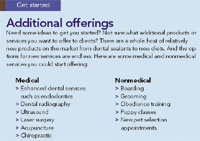Ready set grow!
You're stoked about offering your clients new services and products. But your team's response is underwhelming. Here's how to get started and get your team onboard.
Let's say you attended some terrific sessions at CVC Central at the end of August. And you learned about a terrific new product or service. You're excited about offering this great option to your clients. You couldn't wait to get back to the practice and share what you learned with your team. But when you got back, no one else was interested. And now the product sits on the shelf or the service never gets offered. Sound familiar?
Well, chances are the problem isn't with the product or service, but with your approach. Take these steps anytime you decide to incorporate a new product or service to ensure success.
Research your addition
The first step: Learn all you can about the product or service and how it works. Compare the product with similar products on the market. Is this the best? Will it fit well with other products and services that you're providing? Does the company you're purchasing from provide professional, reliable service and stand behind its product?
When possible, talk to other practices that purchased the product or offered the new service about how well it works. And don't forget to ask whether they've been pleased with the quality and timeliness of the support services the company provided.
It's also important to determine whether adding the new product or service will add another profit center to your practice. For example, if you're adding a new line of diets, are you duplicating ones that you already offer? If so, are you just increasing your inventory? Or will the change add a new dimension to your nutritional offerings?

CE opportunity Get Opperman's advice live
Educate your team and build buy-in
Once you've decided on a new product or service, hold a team meeting. You might invite the company representative to present his or her product and do an in-clinic seminar. The representative can teach doctors and team members how to use the product or service. Some companies may also offer advice from veterinarians or specially trained individuals that are experts at using the product or service.
Also consider hands-on demonstrations that let team members see the product used. You might even ask employees to bring their pets to the hospital for the meeting so they can try the new product or service.
At one practice, several team members brought their pets in to try a new dental product. The team members saw first-hand how wonderful this product was so they supported it immediately. As a side benefit, I believe these team members will also recommend the product to clients with confidence. After all, they can say, "I've used this product on my pet and it's great!"
You could also invite someone who's successfully using the product or service in his or her practice to visit yours. Testimonials pack a lot of power.
I know of one practice owner who wanted to introduce some alternative medical procedures. Most of the team was skeptical. The doctor invited a veterinarian from another practice to visit and perform the procedure on an employee's pet, with her permission, of course. The pet responded to the procedure better than expected, and guess what? This experience turned the skeptics into believers.
As an alternative, you might send some of your team members to another practice that's using the product or service. Seeing a successful implementation can help to ensure success in your practice. The bottom line: Your team must believe in the product or service you're introducing.
Develop a marketing plan
OK, so now you have this new product or service and the team believes in it. What's next? The all-important marketing plan. You need to determine how you'll introduce this new product or service to your clients and educate them about it.
The company that sold you the product may be helpful. Some even provide brochures, client handouts, and even marketing materials you could use in the media to help educate clients and spread the word that you're offering this service.

Get started Additional offerings
Depending on what you're offering, you may want to send clients information about this new product or service. If it's a product that will benefit a specific subset of your patients, search your records for patients with those criteria and send a marketing piece to just those pet owners. You might focus on a particular species, age, or gender, depending on the product or service.
For example, if you're introducing a service for senior patients, you might identify all the patients 5 or 6 years old or older that visited the hospital in the past 12 to 24 months. Nearly all veterinary software programs let you search and sort by these types of criteria. Once you identify a target list of clients, send them a letter or educational materials.
You could also market your new product or service by including a short article about it in your practice newsletter or by printing a quick message on the bottom of your client receipt or reminder cards. One practice team I know printed, "Remember the lessons of Katrina, microchip your pet today," on their receipts. A little bold, I'll admit, but highly successful in that practice.
It's also important to follow through on the marketing plan in the exam room. When appropriate, the doctors and exam room assistants should recommend the new product or service when clients visit the practice.
Measure your success
How well would a football team, basketball team, or any other team do if they didn't know the score until the game was over? You just got your team members involved in providing this new product or service; don't they deserve to know how well they're performing? Post a graph or chart on the wall showing how many times the new service has been performed or how many units of the new product you sold. Update the graph daily or weekly.
Many practices also incorporate a reward as part of their marketing program. Let's say you're incorporating a senior wellness program or a safety and comfort package for your surgical cases. As part of your marketing program, you might decide that your goal is to provide this service 50 times in October. The team works together to accomplish this goal. And if it's achieved, the entire team might receive a monetary bonus or go out for a fancy dinner. One team rewarded itself by going to a paintball arcade. The group had tons of fun!
Incorporating a new product or service should be a positive experience for the whole team. So the next time you get excited about a new product or service—maybe this month, at CVC West in San Diego—make sure you take the time to communicate the reasons for your excitement. Your team needs to share your enthusiasm and understand the benefits to their patients. And when they do, they'll help make that great new service a success.

Mark Opperman
Veterinary Economics Hospital Management Editor Mark Opperman is a certified veterinary practice manager and owner of VMC Inc., a veterinary consulting firm based in Evergreen, Colo. Send your comments to ve@advanstar.com.